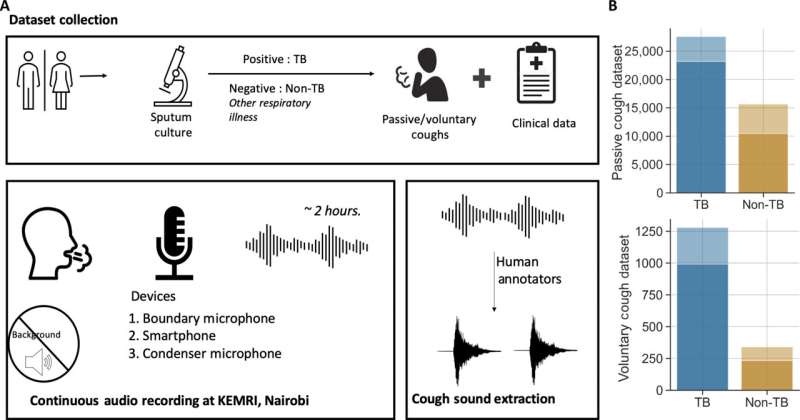February 7, 2024 feature
This article has been reviewed according to Science X's editorial process and policies. Editors have highlighted the following attributes while ensuring the content's credibility:
fact-checked
peer-reviewed publication
trusted source
proofread
Can an experimental cell phone app screen coughs for TB? Scientists say 'yes'

What telltale features—many inaudible to the human ear—separate one kind of cough from another? Scientists are on the verge of finding out with a new machine learning tool aimed at identifying the signature sounds of tuberculosis.
Cough is a leading symptom of respiratory infections. And because the pattern and frequency of cough episodes differ from one disease to the next, an effort is underway to develop a smartphone app that is sensitive enough to accurately discern coughs associated with TB.
For years, researchers have been on the hunt for a low-cost, high-tech TB screening tool, particularly for use in resource-challenged regions of the world, where health care infrastructure is lacking and diagnostic tools are in low supply.
Both the incidence and mortality of TB are again on the rise after years of decline, intensifying the need for accurate screening tools. Current gold standards for TB diagnosis include sputum culture or GeneXpert molecular tests. But while these diagnostics are highly accurate, their cost is a concern in parts of the world hardest hit by TB.
An international team of researchers is testing the hypothesis that TB's unique pattern and frequency of coughing can provide sufficient data to screen for the highly infectious bacterial disease using technology engineered into a smartphone app.
Currently in the investigational phase, the app is not yet ready for distribution. At present it is a machine-learning tool called TBscreen, but given the rising numbers of TB cases around the globe, its development couldn't have arrived at a more opportune time.
Writing in Science Advances, a team of collaborators at the University of Washington in Seattle and Kenya's Center for Respiratory Diseases Research in Nairobi published data about their investigational app. The research team includes engineers and computer scientists as well as physicians and experts in infectious diseases.
When they entered audio of coughs through various microphones into TBscreen, the team found that TBscreen—the investigational app—and a smartphone mic identified active TB more accurately than when cough audio was fed through expensive microphones.
"To investigate cough characteristics as an accurate classifier of TB versus non-TB–related cough, we enrolled adults with cough due to pulmonary TB and non-TB–related etiologies in Nairobi, Kenya," writes Manuja Sharma an engineer at the University of Washington in Seattle.
The machine-learning tool is being "trained" to recognize pattern and frequency in coughs caused by TB. The investigational app also is being trained to distinguish TB-related coughs from those caused by other respiratory disorders.
Researchers have found that there are numerous factors affecting the basic patterns of coughing, nuances—some inaudible to the human ear—that the tool must discern as a way to accurately screen for TB.
"The mechanism of cough production varies according to mucus properties, respiratory muscle strength, mechanosensitivity, chemosensitivity of airways, and other factors resulting in diverse cough sounds," added Sharma, lead author of the new analysis.
"We constructed a study design with minimal background noise and environmental variability between the controls and TB disease groups to ensure that the model trains on differences in cough features rather than ambient noise," Sharma explained, referring to the app, a machine-learning tool.
The new cough-classifying technology was tested by analyzing 33,000 passive coughs and 1,200 forced coughs from 149 patients with pulmonary TB and 46 patients with other respiratory conditions. TBscreen was able to distinguish active TB from non-TB coughs with an overall accuracy of roughly 82%. The team found that the app and a smartphone mic predicted which coughs signified active TB more accurately than using more expensive microphones.
TBscreen performed best when using Pixel smartphone audio, to evaluate passive coughs, and identifying coughs from patients with higher bacterial loads. The last element indicates TBscreen's potential as a triage tool because patients with elevated bacterial loads tend to be sicker.
All participants were enrolled in the study at the Kenya Medical Research Institute in Nairobi, where Dr. Videlis Nduba headed that part of the analysis. Each participant was told to sit in a quiet room and allow the cough reflex to occur naturally. Their coughs were recorded for two hours. The group of 46 controls whose coughs were also recorded for two hours followed the same instructions.
This isn't the first time that medical scientists have considered cough as a possible audio marker for TB diagnosis, screening or monitoring. Last year, scientists at the University of California, San Francisco reported study results on the use of a cell phone app to monitor cough frequency among patients being treated for TB.
The UC San Francisco research involved collaborators in Uganda, South Africa, India, The Philippines and Vietnam, all regions of the world where TB incidence remains significantly high. That app allowed round-the-clock data collection on patients' coughs.
TB is caused by the inhalation of the bacterium Mycobacterium tuberculosis, and it is the second-leading infectious cause of death after COVID, Sharma and her team reported.
In 2022, the most recent year for complete statistics from the World Health Organization, TB infected 10.6 million people globally and killed an estimated 1.4 million. Tuberculosis, which is largely spread through coughing and sneezing, has been infecting people for at least 9,000 years, and for centuries was the leading cause of infectious disease deaths. The COVID pandemic pushed TB to the No. 2 spot.
"Our findings support the feasibility of using a widely available recording device—smartphones—for a point-of-care cough-based TB screening," Sharma concluded, noting that the basic framework behind this screening strategy may also advance research in the diagnoses of other pulmonary diseases.
More information: Manuja Sharma et al, TBscreen: A passive cough classifier for tuberculosis screening with a controlled dataset, Science Advances (2024). DOI: 10.1126/sciadv.adi0282
© 2024 Science X Network



















